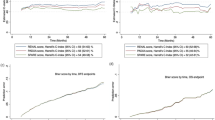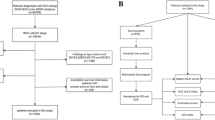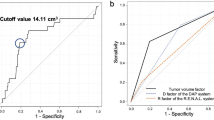Abstract
Purpose
Aim of the present study was to develop and validate a nomogram to accurately predict the risk of chronic kidney disease (CKD) upstaging at 3 years in patients undergoing robot-assisted partial nephrectomy (RAPN).
Methods
A multi-institutional database was queried to identify patients treated with RAPN for localized renal tumor (cT1-cT2, cN0, cM0). Significant CKD upstaging (sCKD-upstaging) was defined as development of newly onset CKD stage 3a, 3b, and 4/5. Model accuracy was calculated according to Harrell C-index. Subsequently, internal validation using bootstrapping and calibration was performed. Then nomogram was depicted to graphically calculate the 3-year sCKD-upstaging risk. Finally, regression tree analysis identified potential cut-offs in nomogram-derived probability. Based on this cut-off, four risk classes were derived with Kaplan–Meier analysis tested this classification.
Results
Overall, 965 patients were identified. At Kaplan–Meier analysis, 3-year sCKD-upstaging rate was 21.4%. The model included baseline (estimated glomerular filtration rate) eGFR, solitary kidney status, multiple lesions, R.E.N.A.L. nephrometry score, clamping technique, and postoperative acute kidney injury (AKI). The model accurately predicted 3-year sCKD-upstaging (C-index 84%). Based on identified nomogram cut-offs (7 vs 16 vs 26%), a statistically significant increase in sCKD-upstaging rates between low vs intermediate favorable vs intermediate unfavorable vs high-risk patients (1.3 vs 9.2 vs 22 vs 54.2%, respectively, p < 0.001) was observed.
Conclusion
Herein we introduce a novel nomogram that can accurately predict the risk of sCKD-upstaging at 3 years. Based on this nomogram, it is possible to identify four risk categories. If externally validated, this nomogram may represent a useful tool to improve patient counseling and management.



Similar content being viewed by others
Data availability
The data presented in this study are available on request from the corresponding author. The data are not publicly available due to privacy and ethical restrictions.
References
Ljungberg B, Albiges L, Abu-Ghanem Y et al (2022) European Association of Urology Guidelines on Renal Cell Carcinoma: The 2022 update. Eur Urol 82:399–410. https://doi.org/10.1016/j.eururo.2022.03.006
Simone G, Tuderti G, Anceschi U et al (2017) Oncological outcomes of minimally invasive partial versus minimally invasive radical nephrectomy for cT1-2/N0/M0 clear cell renal cell carcinoma: a propensity score-matched analysis. World J Urol 35:789–794. https://doi.org/10.1007/s00345-016-1923-2
Luzzago S, Palumbo C, Rosiello G et al (2020) Effect of stage and grade migration on cancer specific mortality in renal cell carcinoma patients, according to clear cell vs. non-clear cell histology: a contemporary population-based analysis. Urol Oncol 38:506–514. https://doi.org/10.1016/J.UROLONC.2020.02.004
Alameddine M, Koru-Sengul T, Moore KJ et al (2019) Trends in utilization of robotic and open partial nephrectomy for management of cT1 renal masses. Eur Urol Focus 5:482–487. https://doi.org/10.1016/J.EUF.2017.12.006
Simone G, De Nunzio C, Ferriero M et al (2016) Trends in the use of partial nephrectomy for cT1 renal tumors: Analysis of a 10-yr European multicenter dataset. Eur J Surg Oncol 42:1729–1735. https://doi.org/10.1016/j.ejso.2016.03.022
Ferriero M, Brassetti A, Mastroianni R et al (2022) Off-clamp robot-assisted partial nephrectomy for purely hilar tumors: technique, perioperative, oncologic and functional outcomes from a single center series. Eur J Surg Oncol 48:1848–1853. https://doi.org/10.1016/J.EJSO.2022.01.024
Tuderti G, Brassetti A, Mastroianni R et al (2022) Expanding the limits of nephron-sparing surgery: surgical technique and mid-term outcomes of purely off-clamp robotic partial nephrectomy for totally endophytic renal tumors. Int J Urol 29:282–288. https://doi.org/10.1111/iju.14763
Nientiedt M, Bertolo R, Campi R et al (2020) Chronic kidney disease after partial nephrectomy in patients with preoperative inconspicuous renal function—curiosity or relevant issue? Clin Genitourin Cancer 18:e754–e761. https://doi.org/10.1016/j.clgc.2020.05.007
Flammia RS, Anceschi U, Tufano A et al (2022) Is hypertension associated with worse renal functional outcomes after minimally invasive partial nephrectomy? Results from a multi-institutional cohort. J Clin Med 11:1243. https://doi.org/10.3390/JCM11051243
Pecoraro A, Campi R, Bertolo R et al (2023) Estimating postoperative renal function after surgery for nonmetastatic renal masses: a systematic review of available prediction models. Eur Urol Oncol 6:137–147. https://doi.org/10.1016/j.euo.2022.11.007
Martini A, Cumarasamy S, Beksac AT et al (2018) A nomogram to predict significant estimated glomerular filtration rate reduction after robotic partial nephrectomy. Eur Urol 74:833–839. https://doi.org/10.1016/j.eururo.2018.08.037
Kutikov A, Uzzo RG (2009) The R.E.N.A.L. nephrometry score: a comprehensive standardized system for quantitating renal tumor size, location and depth. J Urol 182:844–853. https://doi.org/10.1016/J.JURO.2009.05.035
Simone G, Gill IS, Mottrie A et al (2015) Indications, techniques, outcomes, and limitations for minimally ischemic and off-clamp partial nephrectomy: a systematic review of the literature. Eur Urol 68:632–640. https://doi.org/10.1016/j.eururo.2015.04.020
Edge SB, Compton CC (2010) The American Joint Committee on Cancer: the 7th edition of the AJCC cancer staging manual and the future of TNM. Ann Surg Oncol 17:1471–1474. https://doi.org/10.1245/S10434-010-0985-4
Clavien PA, Barkun J, de Oliveira ML et al (2009) The Clavien–Dindo classification of surgical complications: five-year experience. Ann Surg 250:187–196. https://doi.org/10.1097/SLA.0B013E3181B13CA2
Levey AS, Stevens LA, Schmid CH et al (2009) A new equation to estimate glomerular filtration rate. Ann Intern Med 150:604. https://doi.org/10.7326/0003-4819-150-9-200905050-00006
Stevens PE, Levin A (2013) Evaluation and management of chronic kidney disease: synopsis of the kidney disease: improving global outcomes 2012 clinical practice guideline. Ann Intern Med 158:825–830. https://doi.org/10.7326/0003-4819-158-11-201306040-00007
Bellomo R, Ronco C, Kellum JA et al (2004) Acute renal failure—definition, outcome measures, animal models, fluid therapy and information technology needs: the Second International Consensus Conference of the Acute Dialysis Quality Initiative (ADQI) Group. Crit Care. https://doi.org/10.1186/CC2872
Anceschi U, Ferriero MC, Tuderti G et al (2021) Head to head impact of margin, ischemia, complications, score versus a novel trifecta score on oncologic and functional outcomes after robotic-assisted partial nephrectomy: results of a multicenter series. Eur Urol Focus 7:1391–1399. https://doi.org/10.1016/J.EUF.2020.06.021
Bhindi B, Lohse CM, Schulte PJ et al (2019) Predicting renal function outcomes after partial and radical nephrectomy. Eur Urol 75:766–772. https://doi.org/10.1016/j.eururo.2018.11.021
Mari A, Tellini R, Antonelli A et al (2022) A nomogram for the prediction of intermediate significant renal function loss after robot-assisted partial nephrectomy for localized renal tumors: a prospective multicenter observational study (RECORd2 Project). Eur Urol Focus 8:980–987. https://doi.org/10.1016/j.euf.2021.09.012
Campbell SC, Campbell JA, Munoz-Lopez C et al (2023) Every decade counts: a narrative review of functional recovery after partial nephrectomy. BJU Int 131:165–172. https://doi.org/10.1111/BJU.15848
Cacciamani GE, Medina LG, Gill TS et al (2019) Impact of renal hilar control on outcomes of robotic partial nephrectomy: systematic review and cumulative meta-analysis. Eur Urol Focus 5:619–635. https://doi.org/10.1016/J.EUF.2018.01.012
Crocerossa F, Fiori C, Capitanio U et al (2022) Estimated glomerular filtration rate decline at 1 year after minimally invasive partial nephrectomy: a multimodel comparison of predictors. Eur Urol Open Sci 38:52–59. https://doi.org/10.1016/j.euros.2022.02.005
Blackmur JP, Gaba F, Fernando D et al (2021) Leibovich score is the optimal clinico-pathological system associated with recurrence of non-metastatic clear cell renal cell carcinoma. Urol Oncol 39:438.e11-438.e21. https://doi.org/10.1016/j.urolonc.2021.04.007
Campbell SC, Uzzo RG, Karam JA et al (2021) Renal mass and localized renal cancer: evaluation, management, and follow-up: AUA guideline: Part II. J Urol 206:209–218. https://doi.org/10.1097/JU.0000000000001912
Yamada T, Wakabayashi M, Bhalla A et al (2021) Cardiovascular and renal outcomes with SGLT-2 inhibitors versus GLP-1 receptor agonists in patients with type 2 diabetes mellitus and chronic kidney disease: a systematic review and network meta-analysis. Cardiovasc Diabetol 20:14. https://doi.org/10.1186/s12933-020-01197-z
Beksac AT, Carbonara U, Abou Zeinab M et al (2022) Redo robotic partial nephrectomy for recurrent renal tumors: a multi-institutional analysis. J Endourol 36:1296–1301. https://doi.org/10.1089/END.2021.0954
Brassier M, Khene ZE, Bernhard JC et al (2022) Percutaneous ablation versus surgical resection for local recurrence following partial nephrectomy for renal cell cancer: a propensity score analysis (REPART Study-UroCCR 71). Eur Urol Focus 8:210–216. https://doi.org/10.1016/J.EUF.2021.02.007
Flammia RS, Tufano A, Proietti F et al (2022) Renal surgery for kidney cancer: is preoperative proteinuria a predictor of functional and survival outcomes after surgery? A systematic review of the literature. Minerva Urol Nephrol 74:255–264. https://doi.org/10.23736/S2724-6051.21.04308-1
Author information
Authors and Affiliations
Corresponding author
Additional information
Publisher's Note
Springer Nature remains neutral with regard to jurisdictional claims in published maps and institutional affiliations.
Rights and permissions
Springer Nature or its licensor (e.g. a society or other partner) holds exclusive rights to this article under a publishing agreement with the author(s) or other rightsholder(s); author self-archiving of the accepted manuscript version of this article is solely governed by the terms of such publishing agreement and applicable law.
About this article
Cite this article
Flammia, R.S., Anceschi, U., Tuderti, G. et al. Development and internal validation of a nomogram predicting 3-year chronic kidney disease upstaging following robot-assisted partial nephrectomy. Int Urol Nephrol 56, 913–921 (2024). https://doi.org/10.1007/s11255-023-03832-6
Received:
Accepted:
Published:
Issue Date:
DOI: https://doi.org/10.1007/s11255-023-03832-6




